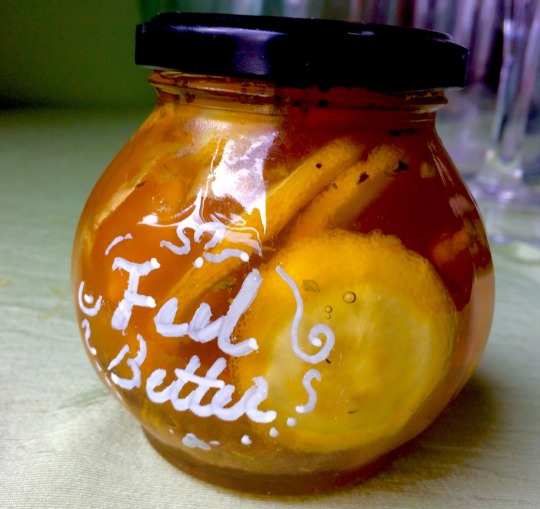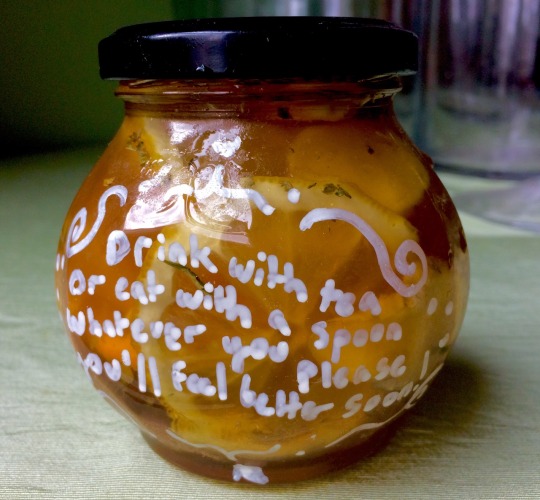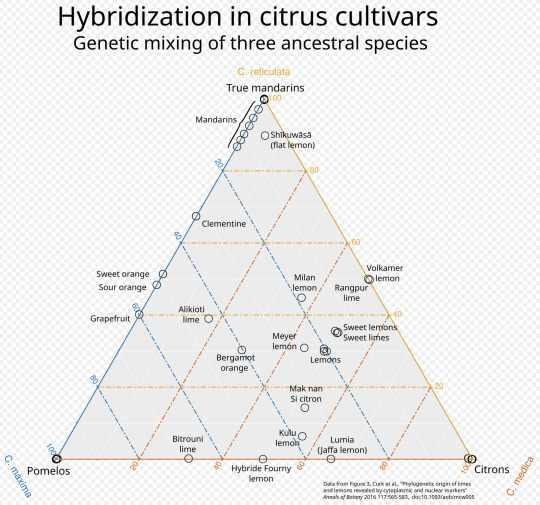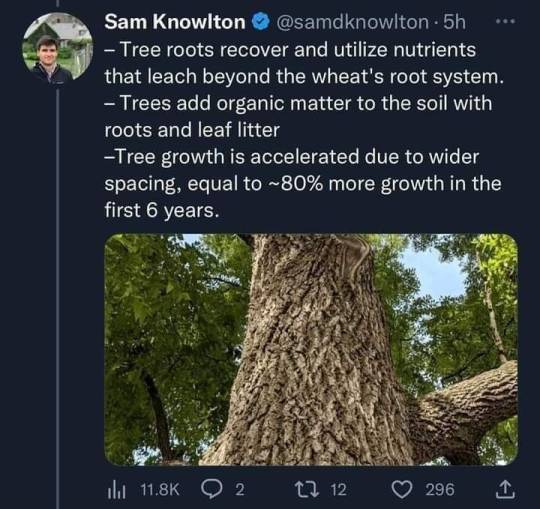Text
i got into ecology because i want to make the world better and now it seems like the left can’t decide if they love or hate this entire field of science. so that’s neat.
2K notes
·
View notes
Text
Ok but false cinnamon (the sort that's easy to find in stores) has a fair amount of a compound in it that's not good for your liver. Having had a few cups is probably fine but i expect it would get unsafe if you were to drink this much on a regular basis.
There is a compound in nutmeg that causes some horrible hallucinations for a goot couple of days. I understand one needs to consume large amount of nutmeg to induce this, however i have no idea how much, nor if the compound is water-soluble.
Don't assume larger-than-standard quantities of herby things (or OTC meds) is safe, 'cause sometimes it's not! & this doesn't mean you can't / shouldn't enjoy drinking this, but for the future it's probably worthwhile making sure that you are aware of any risks (informed decisions require information!) and figuring out how much / frequently it should be safe to drink.
so i made a potpourri with cinnamon and nutmeg and ginger and cloves and orange peel and anise and i have boiled it all day and it smelled so nice i took a sip and the sip was actually wonderful so now i have drunk four cups of potpourri juice and i am only now going to the internet to ask if i am going to Experience The Torments. or if i may have a fifth.
(i cannot quite explain it, but it’s like my entire low i have had a low grade stomachache, and normally i just deal but This Juice helps a little. i am unreasonably fond of it.)
#I'm not judging the 'whoops i didn't consider it before doing it'#because i had a few cups of false cinnamon tea for a few days in a row before thinking 'hold on maybe i should double-check safety'#Also i believe ginger often helps with nausea so i'm inclined to think that may be a contributing factor to aiding your stomach problem?#No idea at all about aniseed or star anise or cloves medicinally / riskily#Also do i get pedantic about 'this isn't tea this is an infusion?' Nah. Language changes and i guess herbal infusions are herbal teas now.
10K notes
·
View notes
Photo


So I made this ‘elixir’ as my coworkers call it for me and a friend cause we are both sick. I bought mine to work for my sick coworkers to try and they loved it. It’s a jar of sliced ginger and lemon and filled with honey and if you let it sit overnight in the fridge it turns into a loose syrup you can use as a cough syrup or to soothe sore throats or mix it in your tea. I added a tiny bit of Damiana cause it helps lift your spirits and a tiny pinch of gold food glitter that makes it sparkle subtly gold to help it feel more magical. It also makes your teas lightly sparkly. My coworkers were calling it a magic brew and potion it was hilarious. I wrote a little thing for my sick friend on it using a paint pen, since she’s a witch too she would find it cute:
Drink with tea Or eat with a spoon Do whichever you please And you’ll feel better soon!
4K notes
·
View notes
Note
I'm sorry to hear about your explody & injured pieces :c
If it's ok to ask, do you know what likely caused the pottery to explode? I think i know a couple of the basic causes (i'm not a potter myself, i just like knowing stuff) but i'm sure you're plenty experienced enough to not make a hollow sealed piece on purpose, so i guess i'm just wanting to get a better idea of more subtle accidental causes of this, if you happen to know.
I'm glad most of your pieces survived though, and that you were still able to share photos of the un-fired pieces with us!
thanks, the anguish is lessening lol. having pictures of them does help. and I’ll be recreating all four of them over the next couple months.
the reason they exploded was because they were slightly damp in the centre. the water in the clay expands so fast as it turns to steam that the clay literally explodes.
and, fun fact, you can make a hollow sealed piece and fire it safely. I’ve seen someone make and fire a hollow sphere. but that’s a very common misconception. my first pottery teacher taught me that, and I didn’t learn it was false for a few years.
32 notes
·
View notes
Text







32K notes
·
View notes
Note
Hey! I'm not a botanist, but I'm in circles where it's a bigger thing and I'm kind of curious about something.
So, from an outsider's perspective, the genus Garcinia has a lot of weird and messy classifications. For example, common species like G. intermedia and G. gardneriana are really similar to Garcinia brasiliensis, to the point that it's pretty controversial if they're actually separate species. The Garcinia species colloquially known as "achachairú" also appears to bear a lot of similarities to that trio (although much less than they share with each other), HOWEVER it's almost exclusively referred to (in cultivation and in studies) as G. humilis, a Carribean species with small oval-shaped leaves, despite actually having very long lanceolate leaves and being exclusively found in the Andean foothills of Bolivia. Also, multiple frequently cultivated species like Luc's garcinia and Russell's sweet garcinia haven't actually been described yet, despite for example the former having a decent amount of scientific interest and frequent genetic testing done on it.
All of these odd classification things and even more others have been pretty well known in my circles for the past 15 years-ish, but still nobody seems anywhere close to a conclusion for them. How long does it usually take for a genus to get organized when it has as many species as Garcinia does? And how do they do it? Do they go around testing every single species or only a few at a time? If a species is currently not named, do the same people usually describe them as part this endeavor, or just leave them for somebody else? I saw Plinia and Artocarpus recently got reshuffled a lot because of some prominent genetic studies on them, and several new species and even genera were added, but it just seems alien to me how stuff like that even ends up happening. There are so many plants out there!
Sorry if I'm asking the wrong person here, but I've been wondering about how this stuff will eventually be resolved for yeeeearrs
There are so many plants out there!
ok im kind of surprised i can offer a few possible answers to this question despite having never heard of this but i think i can. if the question is 'why aren't some plants actually described', this is the primary reason why.
when i was in plant anatomy class in college, the person teaching us was a plant anatomist who assigned us different plants from the greenhouse to dissect and describe in a paper for her, and she told us that we might find something that hadn't been described before, which was pretty shocking to me. what do you mean i could potentially find a new-to-science thing? has nobody in history looked at this plant that's just growing in the greenhouse upstairs??
what she said was that no, sometimes not. there are so many plants out there that it's difficult to do one exact in-depth description and published examination of each species, so what botanists end up doing is doing or finding one in-depth examination of one species in a specific group and assuming that all the others in the group are at least similar, if not the same. which is good because it saves time and works as a shorthand, especially if there's not much funding, but also sometimes it has the potential to overlook more nuanced differences that can go undiscovered for a long time. but that's just botanical species in the conventional sense, which i don't think is as straightforward in what you're describing.
another answer to this question that's more specific to the species you're talking about here is that plants are having sex. they have so so so soooo much sex. few things they enjoy more to be honest. and given that the most conventional (but not only) definition for different species is 'can't have sex with other species because it's too different from them', the lines get blurrier to deal with, and one thing botanists do when the lines between species get too blurry (because of all the sex) is to just assume that they're all part of some kind of hard-to-describe genetic soup with individual plants falling along gradients or spectrums of similarities or differences, and in this case you'll see botanists just name the most prominent species among them and call it the '[most common suspect] complex', which groups together all the ones that happen to be having sex with each other at the same time, just to make them easier to talk about. this typically doesn't mean that they're species-less, but more that they can be thought of as a group with a few distinct points where they can look very distinct, and those points are the species, if that makes sense; see the citrus sex graph at the end for an example.
i also see from a cursory google search that people seem to be planting and eating these in a more widespread way, and people are talking about them on forums and stuff. this is one of the cases in botany where things get tricky, because a person looking for traits in a fruit that's having tons of sex might not actually be looking for the same things botanists are looking for when describing a species-- it might seem easiest to just find which species or few species are the tastiest and grow those, but if it's a genetic soup then all you can really do is do it the old fashioned way and breed individual plants for the traits you want. which, who knows, could end up being a hybrid between all of them.
case in point: again i am not completely up to date with the lore here but i found a forum thread where people were debating which species to plant and the consensus was just to plant multiple species at once, which is fine but is also really funny given that it DOES facilitate even more sex, thus blurring the lines even further and-- if the posters decide to plant the resulting seeds from the fruits-- will create even MORE hybrid plants of no discernible concrete species in the plant soup. the hybrid of a hybrid of a hybrid of a hybrid or whatnot. when does one stop calling it a hybrid between two species and start calling it 'the tree in grandma's backyard that's the tastiest of the berries i've tried'? that is the question, truly, one humanity has had for millennia in the search for the tastiest berry, and at that point it might just be easier to call it a variety or cultivar, which are horticultural terms for just that-- a distinct 'kind' among the same species that taste good subjectively and can be reliably rebred and harvested, like all the apple varieties people debate about.
another reason is that plant phylogenies are hard and brain-twisting and plant taxonomists and systemisists are among our strongest warriors. it's not uncommon at all in botany to be researching something and to find out it's been reshuffled because of a new breakthrough on the case a bunch of people more qualified on the subject decided made more sense like a decades later. sometimes species themselves will even change names multiple times if it turns out that it was described earlier by someone else considering the new circumstances. if you're a really unlucky or just controversial plant all this can happen over and over again until, finally, the trees of math have been resolved in a way that makes sense. how long will it take? surely there is a concrete end to the madness? nah. lol
finally, if you're looking into studies on this, you should know that some phylogeny stuff is opinion-based or subjective, especially at first. what counts as a new group for one group of researchers might not count as one for another. so when you see stuff where people are inventing new categorizations or genuses or whatnot or merging multiple ones together spontaneously, it'll depend on how well supported their reasoning is and what the evidence seems to show, and the larger community of plant taxonomists will, overtime, decide what they want to do with that information-- which may include verifying it or refuting it with more evidence. what researchers are proposing when they split stuff off or merge it together is a new or updated model for thinking about existing information, and that model may be more or less useful than the existing one for the means of actually learning more about the plants.
anyway in short there are lots of reasons why this might not be sorted out and the more sex these plants have the longer it's gonna take. i'm strongly reminded of that one citrus sex graph (its this one) (screenshotted to see it on night mode):

338 notes
·
View notes
Text
Really says something about the dire state of offerings for men interested in sewing their own clothes that even searching things like “interesting men’s clothing patterns” brings up articles with links to four or five whole websites that primarily offer admittedly nice but practically identical patterns for making button-ups and work pants and maybe a varsity/bomber jacket if you’re lucky.
(Branching out into historical costuming for everyday wear is like your one shot at variation, and even then, the ratio of men’s to women’s patterns on every website is frustrating to say the least.)
Patternmakers as a trans man I am begging you. Give me a little more to work with here.
20K notes
·
View notes
Text

Hey, here's another good freezer meal.

It's 3lbs of grated russet potatoes, 3 diced bell peppers, 1 pint chopped mushrooms, 2 large chopped onions, 1 cup chopped spinach. Prep the veggie potato mix and combine in a large bowl.
Pack into five 1 quart freezer bags, press flat, and freeze for later cooking. Remove from freezer and thaw in the fridge before cooking, or cook from frozen over low heat until thawed, then cook normally.

Cook 1 quart at a time in a large frying pan (image is 1/2 quart), heating over medium until onions are translucent. Add salt, pepper, garlic, and chili powder to taste as you cook.

Add 4 eggs per quart and scramble into potato veg mixture. (You can also add chopped bacon to cook with this, or you can sub out eggs for silken tofu)

Press flat in the pan and cook until a crisp bottom forms, then flip and finish heating until eggs are completely cooked.

Tasty, filling, cheap, and easy to cook. It's a lot of prep but you pay upfront for the labor you save later.
296 notes
·
View notes
Text
okay so if you need more veggies/fruit, protein or fibre (bc most people do NOT eat enough) in your diet but you struggle to do so, hear me out:
look up recipes (especially snack recipes) that are child/toddler/baby-friendly
i can guarantee there is a woman with a cooking blog out there who has found away to pack a bunch of vegetables into a surprisingly delicious little snack for her kids. this process has never failed me when i feel like i am not eating enough fruits and veggies. my entire flat is eating spinach muffins at the moment, which doesn’t sounding particularly appealing to most people and yet somehow. they’re delicious.
1K notes
·
View notes
Text
Do any of u have decent recipes that are like 5 ingredients (not including spices) and take 45 mins or less to prepare i gotta stop eating sandwiches for dinner
119K notes
·
View notes
Note
Hello! I was reading your new mattress-FAQ (fantastic, informative, thank you for writing it! I learned a lot) and i thought of an odd question. See, i'm a relatively light person (~55kg) but i sleep under a MINIMUM of 15kg weighted blankets, sometimes 24kg (which used to be my default but my back got twingy a couple seperate times when turning over under them, so i removed one). Would there be any particular new mattress considerations with that extra weight? I was particularly thinking about this when reading the bit about support of the lumbar spine. Also, probably every store is different but do you think it's likely i'd be able to lug some weighted blankets into a store to try out mattresses with the weight of the blankets on me?
(i'm so keen to buy a new matteress because of you, but alas, i won't be able to buy one for at least a year. I'm glad to be able to gather knowledge from you in the meantime so it isn't all new and overwhelming when it's time to start looking!)
The additional weight shouldn’t be an issue since it’s evenly distributed.
My advice would be to go in without them, build rapport with the person helping you, and narrow down beds you like without the blankets. When you’re down to the last one ask to bring them in. The person will say yes and it’ll ultimately save you the effort of lugging them into every bed.
55 notes
·
View notes
Text
FFS’ Guide to Mattresses:
The following is a non-comprehensive list of questions I get asked a lot and is hopefully a good resource for anyone looking for a new mattress. I am not a scientist. I just sell beds. All bed knowledge is centered in the US, my apologies to international folks.
If this guide proves helpful you can consider popping a tip over on my Ko-fi to say thanks!
What’s the first step?
Well, first thing is gonna seem kind’ve obvious but a lot of people get mattresses secondhand and don’t think about it. Determine the feel you like! There’s no reason to sleep on a hard bed unless you like it, it’s not any better for your back. The three standard feels are firm, medium, and soft. Soft is called plush for stupid reasons. So find out which you like! It’ll narrow down what you look at, and save you time.
When trying out mattresses, use an A-B method. Do not compare every bed. Compare two at a time, otherwise you end up a confused mess. Pick one between the two that you like better, then put that one up against the next choice.
When you eliminate a bed it’s dead to you. Forget it. It was not as good as your new favorite and does not deserve to be remembered. If you cannot pick between two you will be tempted to try a third- this is the devil talking. A third will just make your life harder. If you truly can’t pick between beds that are comparable and they both feel nice after feeling your feelings then pick the cheaper one.
Lastly, mattresses are a huge example of “you get what you pay for”. Investing will pay off. Don’t get sticker shocked, budget what you can but know that mattresses can be freakin expensive. If you go into a store and see $5000 price tags, don’t worry, that’s not all they carry, but focus on the feel of the bed at first rather than price tag.
If you find one you love but it’s too much, the salesperson will know a comparable roll down or will usually try to help you get a deal. If you can admit, “I like this but it’s too much” they’ll work with you to find a solution.
What firmness is best?
This varies person to person but firm beds are not necessarily better for your body. Really. There’s two parts to a good mattress: support and comfort. Support goes underneath and is generally springs or incredibly dense foam. If a bed has good support, you can get away with lots of comfort.
The comfort layer exists to be gentle on your joints and pressure points. People who sleep on their side really need this comfort layer. Without this your shoulders and hips can’t circulate blood and you’ll end up tossing and turning every time your arm starts to fall asleep.
Back in the 1950’s when interconnected coils were the only thing on the market it made sense that you needed them to be firm, otherwise you’d get no back support. But nowadays coils are individually free standing, they do a much better job supporting bodies and bonus, they don’t have to be rock hard.
Most people should get somewhere around a medium bed rather than super firm or super soft but it depends on the persons preferences as all three can be good for you.
How can I tell if a bed has good support?
I’m so glad you asked. You lay on it. There’s a natural curve to the human spine. Lay first on your back. The arch in your lower back, that’s your lumbar. A good bed will push up and fill that area. If your muscles are trying to maintain that arch all night without help it will cause back pain and tossing. The more a bed fills your lumbar the better you can sleep.
Next, lay on your side. You’ll want to focus on your shoulders and hips. Good support on your back is great, but a mattress should have enough squish not to pinch off circulation. Lay for at least five minutes on your side unless you hate it right off the bat, I’m not saying every bed needs this in depth just the one you’re seriously considering. If you feel like you already need to roll over it’s too hard, go softer.
Should I get a topper?
A thousand times no. Toppers are used as a wide ranging bandaid from “there’s a hole in my bed” to “my back hurts”. Commercially available foams in toppers are significantly worse than the foams found in beds. They break down faster and sleep hotter than what they make mattresses with.
The only scenario in which you need a topper is if you’re stuck with a bed that’s too firm for you and you need it a little softer. That’s it. It can make your bed a little softer. It cannot fill holes or fix a bed with bad support. Generally aim to be over $200+ or the topper will break down ridiculously fast and be super hot to sleep on.
What do I do if there’s a divot in my bed?
First off, waterproof protectors can help avoid this problem, so take your bed divot as a life lesson and use a protector on all beds going forward. Our sweat and humidity breaks down foam like nobodies business, causing permanent damage.
So you have a divot, what now? Depends how entrenched it is. When beds get slept on every night for years the foam where a body lays compresses down, and the foam around it stays untouched. You’ll naturally start sinking. But you can get up and walk or crawl along all the foam that isn’t get slept on. If your divot is years deep it may be beyond saving but it’s worth a shot.
You can also rotate beds head to foot every six months and switch the side you and your partner sleep on or sleep all over the bed if you’re alone in it.
If the bed is over ten years old thank it for its service and get a new bed.
When should I get a new bed?
It’s worth checking your sleep quality at ten years into a mattress. The average life expectancy of a bed is 7-9 years. Not because the bed gave out necessarily but because human bodies change. We gain and lose weight, suffer injuries and age. A bed that worked for us eight years ago might not be what we need anymore. So just general age check is good. This is subject to the kind of mattress, bed in a boxes average 3-4 years of comfort so check in sooner.
But additionally: if your bed has a deep body trench where you’ve been sleeping, or if you’re waking up achey or in pain. There’s health problems that can reduce your sleep but a lot of people never suspect their mattress is sabotaging their rest, so keep it in mind.
How do I clean my bed?
Oh boy. You don’t. This goes back to water proof protectors. Your bed is not something you can pop in the wash. But it is something you will sweat and live in for upwards of ten years. Dust mites, dead skin cells, dust mite corpses, dust mite feces, allergens, skin oils. All those things will seep into the bed over time and spoiler alert it’s not great to breathe it in every night.
Sheets only catch a fraction of it, so a waterproof protector keeps the bed safe from your sweat breaking it down, but it keeps you safe from all the things that can build up in a mattress.
If you must clean a mattress I recommend a professional steaming service rather than trying to do it on your own but take this going forward: always protect your bed.
When should I get a new pillow?
Does your pillow have a waterproof protector on it? If no the answer is probably “right now”. Doctors recommend keeping a pillow no more than two years. This is because they’ll lose support and get yucky gross over those two years. If you get a memory foam pillow and get a protector on it they can last way longer. My oldest pillow was around seven years old.
Cheap polyfill pillows you buy at Target or Walmart are really only going to last three months before they wear out. If you are using more then one pillow at night you need a new pillow. Every time you have to wake up and adjust the multiple pillows you’re losing sleep.
Memory foam pillows can be more expensive but will last exponentially longer so save up and spend $50+ on a pillow you’ll actually get to use for a long time rather than $10 on one that will give you a few months of comfort.
What do I look for in a good pillow?
A good pillow is an extension of your spinal support. It should keep your neck aligned with your spine. Ideally, you are laying on a bed to try out a pillows height. It should match the width of your shoulder.
Most mattress stores can fit you for a pillow, but you can also bring a buddy to check your spinal alignment is straight. Side sleeping is most critical to get the height right. Back sleeping you just don’t want it too tall to force your chin down, and stomach you want it low enough not to push your neck up.
I replaced my pillow, now what?
Okay so now you might curse my name for a few days. Bodies are creatures of habit and hate change. Your neck might be in agony on the old pillow but it's familiar agony. So when you boot that sucker to the curb don't throw it out right away. As if I'd ever actually throw away a pillow when I could just hoard it forever.
Start each night on your new pillow. If you wake up in pain, switch back to the old one. Each night you should be able to stay on the new pillow longer and longer until your neck is finally happy. If the new pillow is consistently an issue after a week or more it may be too tall/low for you, unfortunately.
If I’m sleeping well do I really need to replace it (beds/pillows)?
Are you really sleeping well? Replacing beds or pillows is inherently stressful and a lot of peoples happy place is their bed. It’s hard to give up aspects of that cozy zone. If you’re really truly sleeping well no one is gonna make you change.
But generally if you find yourself asking this question you may be trying to convince yourself that things are good enough and ignoring that they could be much better.
Get a sleep tracker if some kind. Let it run for a week or two to see how much you’re tossing and waking up. If it’s a lot and your bed/pillow are old, it’s a good bed they’ve served their time.
If you ever wake up to readjust pillows (or at any point you’re using more than one pillow or mattress) then yes. You need a new one.
Good sleep is the result of the least disruptions. Anything you need to adjust in the middle of the night deserves a hard look and a boot to the curb.
Why shouldn’t I have my mattress flat on the floor?
Mold. Mold mold mold. Remember when I talked about how human bodies are humid? We put out a ridiculous amount of moisture as we sleep from exhalations to sweat. That builds up in the sponge under you and then your body heat maintains the ideal temperature to grow all sorts of nastiness.
You would not believe the amount of molded out beds I’ve seen. Even in the most arid areas, mold. It’s not worth it. Do not leave your bed on the floor. There’s like 2” frames if you like a low bed. If you must have your bed on the floor tip it up against a wall to ventilate every day. Mold will not wait for an invitation.
Japanese futons get brought up a lot here and first off- they get moved every night and washed regularly. Then left to ventilate. They understand that if they left it there it would mold.
Why do I sleep in X position?
Generally your body really wants your spine to curve in the right ways. Sleeping on your back would be ideal if the bed gave you everything you needed but most beds struggle to fill the lumbar. So when your muscles can’t hold your lumbar curve and want a break you roll onto your side.
Stomach sleepers are a case of back muscles fully declaring that nothing can support them and opting to invert rather than deal with poor support. It’s fully the worst sleeping position.
Before I sold beds I was almost 100% stomach sleeper due to scoliosis and back pain. Sometimes side. When I got my new bed I switched to only side and occasionally even back, which astonished me. As my bed has become less what I need I’ve reverted to occasional stomach bouts and less back sleeping.
Why don’t you like bed in a box?
Let me count the ways.
Box beds are the fast fashion of the bed world. They essentially corrupt the support part of the bed equation in order to get a product that can feasibly roll up and be compressed down. The foams are all lower density than they should be and give out quicker. The coils are significantly less steel.
The world cried out for an inexpensive bed and companies responded by giving you significantly less bed per dollar. They often use fiberglass as their flame retardant a requirement for all beds and there’s many testimonials about how poorly that’s gone for people.
But now the greatest sin of boxed beds is that they have the audacity to be marketed at the same price points of traditional beds that don’t roll up.
This robs the consumer of longevity. They’re a rip off. I sell them now at my store and I will do everything in my power to turn folks away onto beds that will actually do their damn job rather than bed mimics.
If you have a bed in a box, please understand that you’ll still get up to five years out of it, and you’re not foolish for buying one. They’ll still always be better than an old broken bed, just look to replace it sooner.
What is a good price point for a new bed?
This is really subjective, but you can get a queen size bed with independent coils for around $600. That’s the lowest good back support I’ve seen. You’ll get ten years out of it and it’ll be a bed.
Stepping into the $1000 mark gives better back support and pressure relief. Up from that they’re going to get more conforming.
Beyond $2000+ you’re generally paying for cooling. It’s the number one thing people want in a new bed but it costs more to give.
Rank Costco, IKEA, or bed in a boxes?
Bed in a box are my lowest tier, for reasons I’ve spoken of at length.
IKEA is next. They’re generally not boxed as of the last time I investigated ikea beds but they’re also just bare bones. Not a lot of either support or comfort, they tend to be around dorm quality.
Costco is a bit of a cheat here. See, they’re a wholesaler but mattresses aren’t something that overstocks- they’re made to order. Costco still wanted to offer a cheap option. So Costco gets beds made to order for really cheap. Now how can Costco offer it so much cheaper? By putting roughly 1/3 less stuff in it by category.
I had a spreadsheet laid out at one point to compare a sealy I carried against what looked like a comparable Costco bed. Every single component was shaved down. Each layer of foam, each coil, they all were about 1/3 less material than our better bed.
Now of course Costco sells boxed bed. So a non-boxed Costco bed is still better than an old broken bed and Costco will basically always take it back which is why they score higher than others but you’re still only going to get about three to five years out of it.
If this guide was helpful you can consider popping a tip over on my Ko-fi to say thanks!
1K notes
·
View notes
Text
i am about to bestow upon you the secret butter technique. i am sorry, but it is french. i am sorry again, this only works with cow butter. i am certain plant based butters wouldn’t work, and alternative animal butters may or may not work
has this ever been you: you have a nicely steamed vegetable, or maybe you want to make the best butter noodles, but you know that if you put butter on those it’ll just melt and you end with kind of greasy noodles or vegetables? don’t you wish it was instead a luscious buttery glaze?
introducing: beurre monté
you will take a small sauce pan, and begin heating it with 1-2 tablespoons of water (use very little water) and bring it to a hard simmer or boil
turn the heat down slightly, and add Butter. how much? however much you dare. (start with 3-4 tablespoons and go from there)
you are going to either whisk Aggressively or you can pick up the saucepan, still holding it over the heat, and swirl aggressively so the butter is skating around the sides of the pan
done correctly, you will have liquid butter that is still emulsified. you have made Butter Sauce. season it with a little salt, and toss whatever you want in it.
if you’re butter splits, i’m sorry. you didn’t agitate it enough to maintain the emulsion, and now you have melted butter.
you can use this knowledge to make other sauces by swapping out the water for another liquid. white wine becomes beurre blanc. red wine is beurre rogue.
you want to CUM? sweat minced shallot in a tiny bit of butter, add white wine and cook it out until it’s reduced by about half. then whisk butter in hard. a few flecks of minced thyme or fennel frond stirred thru, and you eat that with a nice seared fish? or scallop? or even shrimp? wow. you will Nut
your boxed mac and cheese game can also be elevated by cooking your pasta and making a beurre monté first, tossing your pasta in that and adding the cheese packet. wow. hey; you’ll cum
go forth now with this butter secret
67K notes
·
View notes
Text
For as long as scientists have studied trees, we have categorised them into two types based on the sort of wood they make. Softwoods include pines and firs and generally grow faster than hardwoods, like oaks and maples, which can take several decades to mature and make a denser wood. However, our recent research has uncovered something completely new: a third category we’re calling “midwood”. This discovery could prove to be valuable in the fight against rising carbon dioxide (CO₂) levels in Earth’s atmosphere – the primary cause of climate change. Trees are natural carbon sinks. This means they absorb huge amounts of CO₂ from the air and store it in their wood. The tulip tree (Liriodendron tulipifera), also known as the yellow poplar, is a top performer in carbon capture. In the mid-Atlantic US, forests dominated by tulip trees store between two and six times more carbon than forests where other species prevail. The tulip tree is already popular in plantations in parts of south-east Asia and cited as a good choice for carbon capture for gardeners and urban planners in the US. This species, along with its close relative the Chinese tulip tree (Liriodendron chinense), belongs to an ancient lineage dating back 50-30 million years — a period marked by significant shifts in atmospheric CO₂. Only these two species survive. And until recently, their chemistry and structure, which might tell us why these trees are so good at capturing carbon, were largely unknown.
[...]
When tulip trees first evolved, atmospheric CO₂ levels were falling from about 1,000 parts per million (ppm) to 500 ppm. This reduction in available CO₂ may have driven tulip trees to develop a more efficient method of carbon storage, leading to their unique macrofibril structure. Today, this adaptation likely contributes to their exceptional ability to sequester carbon. We can no longer assume, when looking at a previously unstudied tree, that it falls into the same two categories (softwood or hardwood) scientists have placed trees in for years. The tulip tree, with its midwood structure, corresponds with a “carbon-hungry” attitude. We are now looking at whether its seemingly unique wood structure is the sole reason it is king of carbon capture, and we are widening our search to find out if there are any more midwood trees – or even more new wood types out there.
9 September 2024
#Always thought it seemed a little odd to treat wood as hardwood or softwood rather than on more of a scale#Wood#trees
132 notes
·
View notes
Photo
lancewood, not lacewood. There's an N in the common English name.




A juvenile lacewood (Pseudopanax crassifolius) in Nelson Lakes National Parks South Island NZ. It can stay like this for up to 20 years, then branches out and shortens its leaves, meanwhile loses the teeth on leaf margin as well. There are theories to explain this, one of them is to avoid to be eaten by moa, the prehistoric giant bird in NZ.
135 notes
·
View notes




